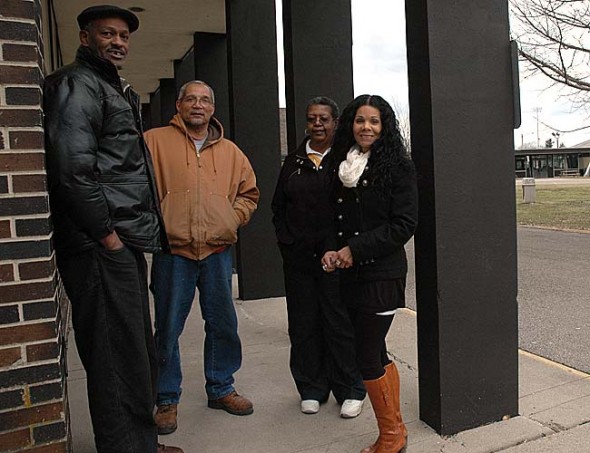
Five Yellow Springs natives, from left, Sterling Wright, Russell Cordell Jr., Jean McKee and Sarah Mabra Cloud (Paul Ford Jr. not shown) will talk about their experiences in Yellow Springs in the 1960s at a Feb. 25 panel discussion and reception at Antioch University Midwest. The program, “Being Black in Yellow Springs: The Sixties Experience,” is the second in a series of events focusing on village African Americans sponsored by the 365 Project. (Photo by Diane Chiddister)
Being black in Yellow Springs
- Published: February 21, 2013
Young people who grew up in Yellow Springs during the 1960s were in a “racial, social and economic bubble” where kids had little awareness of race, class or economic level, according to Yellow Springs natives who will speak soon on the topic, “Being Black in Yellow Springs: The Sixties Experience.” The panel event takes place Monday, Feb. 25, at 6:30 p.m. at Antioch University Midwest, with a reception to follow. Panel members are Jean McKee, Sarah Mabra Cloud, Paul Ford Jr., Russell Cordell Jr. and Sterling “Skeeter” Wright.
“We went to school with the kids whose parents owned the big companies in town,” Wright said recently, referring to Morris Bean, YSI and Vernay Laboratories. “We played together, we stayed all night at each other’s houses.”
Young blacks also felt a sense of equality because African Americans played a vital role in the leadership of the village, the group said. McKee’s father, Jim, was the chief of police, Ford’s father was on the school board, and the mayor, James Lawson, and fire chief, Andy Benning, were African American as well.
“We didn’t have the notion that racism existed,” Wright said, adding “until we went to Fairborn or Xenia. Leaving town is when reality hit.”
Young athletes experienced racism when they played teams from surrounding towns, according to Cordell, who said that some people from other schools “used the n-word.”
But even so, the young people’s parents taught them to be forgiving toward those who showed racist behavior.
“Our parents taught us that those people didn’t know any better,” Wright said.
The 1960s was a “transformational” time of social change, he said, and in Yellow Springs, a visionary high school principal, John Malone, prompted by a group of African-American parents, initiated a course in African-American history taught by a black woman. Before that, according to the group, the local history textbooks reflected textbooks around the country, in that regarding African Americans, “there was one chapter on slavery and that was it.”
In contrast, the new history class spotlighted African Americans who made substantial contributions to American history.
“Here we were on this island not knowing if we were black or white or whatever,” Wright said, and the history course helped to instill pride in the young people’s African-American legacy.
The group will share other stories about growing up black in Yellow Springs in the 60s at the event, which is the second event focused on the African-American experience in the village. The event’s sponsor, the 365 Project, aims to “share the rich, local African-American legacy with our youth and not-yet-elders.”
3 Responses to “Being black in Yellow Springs”
The Yellow Springs News encourages respectful discussion of this article.
You must login to post a comment.
Don't have a login? Register for a free YSNews.com account.













Just came across this. I was in YS in the 60’s. Was a cheerleader at the middle school. Race did not matter to me. I absolutely loved YS and was depressed when I left. I don’t remember Sarah but have fond memories of everyone else. My best to all. Connie Madison
I remember in the 70s and 80s, race really wasn’t much of an issue in YS. Now, decades later, I live in Ferguson.
As a Fairborn resident and teen in the early ’60s, I remember YS as an island of cool release in the buttoned down environment of growing up in So. Ohio. Fairborn was a hick extension of Dayton with an air force base, a cement plant and virtually no black people. They all lived on the West Side of Dayton as far as we knew. When we ventured to YS in those days, we saw all kinds of people. Granted, a lot of freaks, but it was very mind-opening to a kid from Fairborn. I remember vividly a Cecil Taylor concert at Antioch. Had no idea who he was and knew nothing about what I had in store. It was the craziest thing I had ever heard until that point, but I found that I liked it a lot. Now I’m a jazz freak. My brother and I live in WA these days with our families, but still often reminisce about the Little Art, hot donuts, and dogs in the aisle. YS was, and I assume still is, a unique and special place that has left its mark in the lives of many. I wish I could have met some of the people in this article back then. Sorry about their experiences in Fairborn, but I know what they mean. Glad they were able to experience YS instead, and also very glad that I was able to tap into a bit of it, as well. Changed my thinking, and my life, I believe.